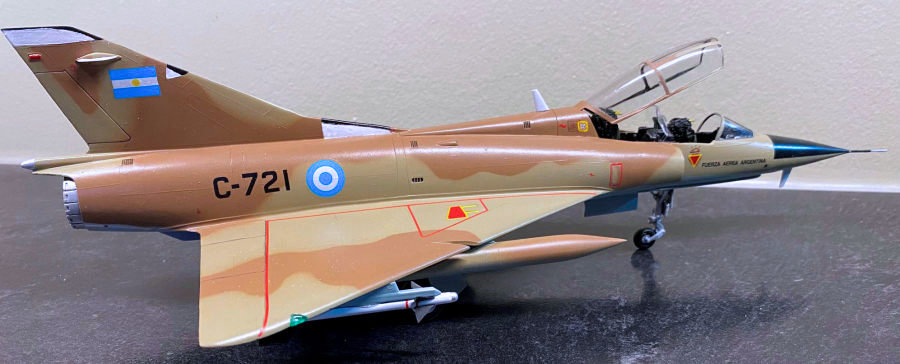
Heller 1/48 Mirage IIIB
| KIT #: | 80411 |
| PRICE: | $ |
| DECALS: | One option |
| REVIEWER: | Pablo Calcaterra |
| NOTES: | Condor 48054 decals. Resin seats |

| HISTORY |
After the loss of more than 30% of the IAI Daggers during the 1982 war the Argentine Air Force had to try to somehow restore her capabilities. The only available feasible option was that of the IIICJ B/C that the Israeli Air Force had used during the wars of 1967/73 and now were in storage. Though the technical staff (i.e. Guillermo Posadas) advised against the acquisition due to the worn out state of these veterans the need and conditions were more important and the Air Force decided to go ahead with the purchase.
By the end of December 1982 four Mirage pilots including some war veterans (Perona, Ballesteros, Sapolski and Selles) had finished flights to accept the Israeli planes. These were painted with Peruvian Air Force colours and serial numbers and transported on three of the ELMA (Argentine Commercial Navy) ships. From Buenos Aires harbor they were transported to Aeroparque Jorge Newbery and from there flown to Rio Cuarto to be inspected and commissioned.
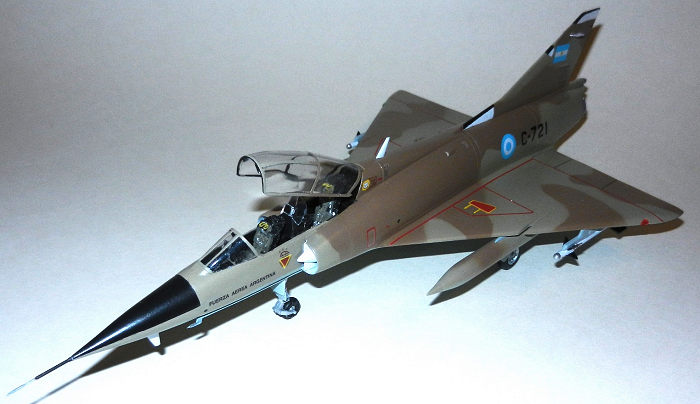 The Atar
09B had been replaced with the 09C and new radios were installed. Cyrano
radars were eliminated and replaced with ballast. These light Mirages were
the most maneuverable in the Air Force and had high chances of defeating
other types during dogfights. Even though the planes had in theory 50% of
shelf life left they were in very bad shape as Posadas had observed. As a
consequence, they were very slowly put in service. Five of them constituted
the Escuadron X (10) of the Grupo 10 de Caza in the newly created X Brigada
Aerea in Rio Gallegos in 1984. They were called “Warriors of Ice” (Guerreros
del Hielo). In parallel a new squadron of CJs was put together in the IV
Brigada Aerea and was led by war veteran Mj Guillermo Donadille. This was
called Escuadron 55 (to honor the 55 members of the Air Force killed during
the war). Planes did not have prominent serial numbers at this point in
order to mislead the Chilean spies lurking in southern Argentina. The first
loss was C-707 in 1985 close to Rio Gallegos. Shafrir AA missiles were
validated. In 1986 with the arrival of the Mirage 5P that Peru had given to
Argentina towards the end of the war the CJs were sent to the IV Brigada
Aerea (Mendoza).
The Atar
09B had been replaced with the 09C and new radios were installed. Cyrano
radars were eliminated and replaced with ballast. These light Mirages were
the most maneuverable in the Air Force and had high chances of defeating
other types during dogfights. Even though the planes had in theory 50% of
shelf life left they were in very bad shape as Posadas had observed. As a
consequence, they were very slowly put in service. Five of them constituted
the Escuadron X (10) of the Grupo 10 de Caza in the newly created X Brigada
Aerea in Rio Gallegos in 1984. They were called “Warriors of Ice” (Guerreros
del Hielo). In parallel a new squadron of CJs was put together in the IV
Brigada Aerea and was led by war veteran Mj Guillermo Donadille. This was
called Escuadron 55 (to honor the 55 members of the Air Force killed during
the war). Planes did not have prominent serial numbers at this point in
order to mislead the Chilean spies lurking in southern Argentina. The first
loss was C-707 in 1985 close to Rio Gallegos. Shafrir AA missiles were
validated. In 1986 with the arrival of the Mirage 5P that Peru had given to
Argentina towards the end of the war the CJs were sent to the IV Brigada
Aerea (Mendoza).
Struggling with reliability there were many pilots trained to fly the CJs. These participated in many large air exercises along other Air Force units. Donadille was replaced with another veteran from the war (Vice commodore Raul Diaz). The later had an incident (purposing) with C-712 and the plane was so distorted due to the violent vibrations that had to be scrapped. Another plane was lost in 1989 when C-705 crashed killing the pilot. Two-seater C-720 crashed killing her pilot but the passenger was able to eject safely. In total 3 planes were complete losses in accidents while many others suffered in flight or on the ground accidents.
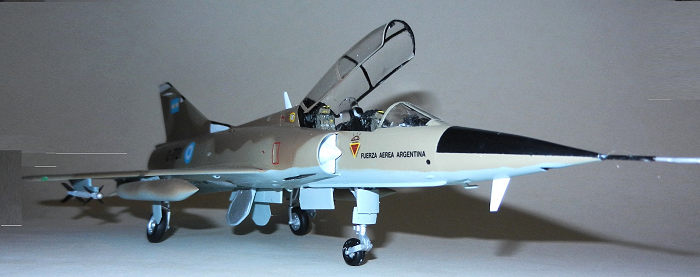 Later on
the planes received their large fuselage numbers and badges on their tails,
always keeping their desert cammo.
Later on
the planes received their large fuselage numbers and badges on their tails,
always keeping their desert cammo.
By 1990 only 8 planes were in service. One plane was destined to the CEASO (JADTEU in the UK) painted in white with red and black stripes and triangles. The Escuadron was closed in 1991 with the 2 two seaters and a single seater being transferred to the VI Brigada Aerea in Tandil (along with all the other Mirages in service). Several airframes are now gate guardians or have been donated to be used as attractions at different city parks.
Some details about some relevant airframes: C-702 was the oldest as it was manufactured in 1961, C-712 is now in the Air Force Museum, C-713 turned out to be an ace airframe with 13 kills (!) obtained during her service in the Israeli Air Force and eventually was sold back for USD1 (yes, one dollar) and now sits in the Hatzerim museum in Israel.
My friend Raul Diaz had the porpoising incident on C-712 and he was flying C-714 when the rear fuselage tank semi detached in flight. I’d think he has used 3 of his lives: when he ejected during the war and during the 2 incidents with the CJs…!
| THE KIT |
Heller has used quite a soft light blue/grey plastic. Panels are mostly raised. It has parts to build a single and two-seater. Details are not particularly fantastic, with the wheel bays being pretty plain (no lines, no pipes, no nothing). External drop tanks are only the supersonic type and no armament is supplied. Decals don’t have good register and are only for French Air Force planes. Clear parts are loose in the box and thus easy to get scratched. Instructions are decent but some vague in some areas.
| CONSTRUCTION |
I decided not to use the seats supplied by Heller but to go with my own resin copies. The assembly of cockpit is very quick as there only very few parts. The instrument panels are the kits painted in black and drybrushed with aluminum.
The nose for the two seater was put together after adding some lead pellets (which I did not glue so when the kit is moved around you have hear them rattling!)
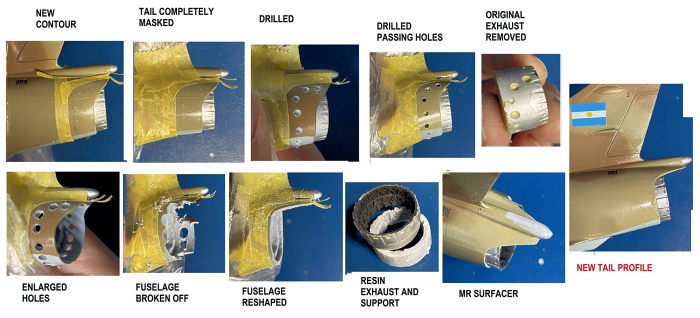 Having
glued the two fuselage halves I dry tested them against the wings assembly. Fit
is not good. I tried to push the fuselage walls outwards while I using pieces of
plastic I also added some support for the top half of the wings in the area
where they touch the fuselage. When all had dried I was forced to add some white
plastic strips to cover the gap between top wings and fuselage. Putty and
sanding delivered a nice union but had to carefully re scribe the panels. The
one along the wing/fuselage was the trickiest one.
Having
glued the two fuselage halves I dry tested them against the wings assembly. Fit
is not good. I tried to push the fuselage walls outwards while I using pieces of
plastic I also added some support for the top half of the wings in the area
where they touch the fuselage. When all had dried I was forced to add some white
plastic strips to cover the gap between top wings and fuselage. Putty and
sanding delivered a nice union but had to carefully re scribe the panels. The
one along the wing/fuselage was the trickiest one.
The cockpit with the nose were added next but here I also had issues as the support tabs leave a gap and the contact surface was not enough to have a firm attachment point. The air intakes were. next. Some putty and sanding were needed. Once this was left behind, I glued the different small intakes and vents, the ventral fin close to the tail and the external stations. Finally, I added the strengthening bars that runs along the nose. Having done this the plane was ready for painting.
For the Shafrirs I took some from the spares (believe from the HC Skyhwaks…or were they ESCI’s Mirage III?), cut the body short a bit (per scale plans). The 500 supersonic tanks were easy to assemble but they only have 2 fins. Those in use in the Argentine Air Force had 3 fins. Thus, I had to re do them using Evergreen.
| COLORS & MARKINGS |
Canopy and windshield were given a coat of Vallejo black primer. Then everything received a coat of Vallejo light grey primer. I masked the triangular area at the front of the tail. Air intakes and VHF antennas were painted white. RLM65 was used for the bottom of the plane. After masking it I sprayed the light tan FS30219. Using a picture from Casciani’s article (top view of the planes) I made masks and finally painted the darker brown (FS30118).
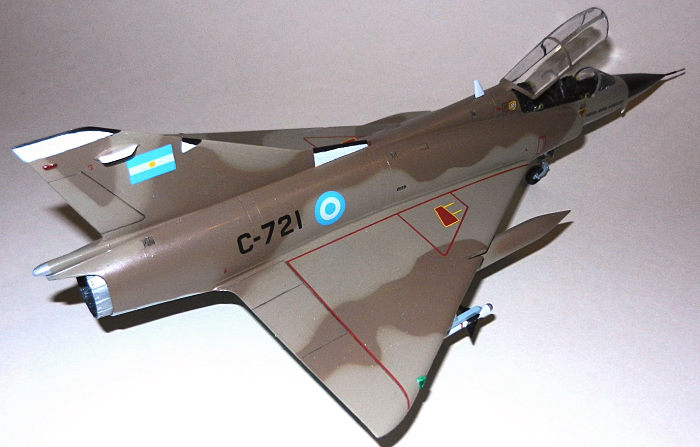 With black I
painted the top of the nose and the edge of the light grey areas of the tail.
Wheel wells and inside of landing gear doors along with legs were painted
aluminum. Shafrirs were painted white with black wings and exhaust pipe with a
silver nose. All different moveable surfaces and grids/vents were highlighted
with a very thin black pencil. Future got the surfaces ready for the decals.
With black I
painted the top of the nose and the edge of the light grey areas of the tail.
Wheel wells and inside of landing gear doors along with legs were painted
aluminum. Shafrirs were painted white with black wings and exhaust pipe with a
silver nose. All different moveable surfaces and grids/vents were highlighted
with a very thin black pencil. Future got the surfaces ready for the decals.
Argentine decals came from the Condor Decals set (roundels, flag on the tail, serial number). Miscellaneous stencils came from the spares and some that I printed myself (like the yellow/black stripped rectangles under the fuselage)
Just before giving the kit a coat of semi-gloss Vallejo I sent a picture to Guillermo Donadille for him to see how nice it was turning out…and then he pointed out that the tail cone was wrong. I had left the profile used in the Atar B and not the C which delivers a longer parachute housing. So now I had to decide to leave as it was (inaccurate) or find a way to address it. I went with the more complicated one: fix it! I first wrapped the entire plane minus the tail cone area with a very thin clear plastic bag. Once this one was secured in place, I proceeded to draw the new tail cone profile with a pencil. For the rest of the process please see the sequence in the picture attached.
| FINAL CONSTRUCTION |
Navigation lights were painted using clear red and green. The kit was sprayed with ModelMaster semi-gloss clear. Like I always do I started to add the final bits inside out starting on the undersides: wheels, landing gear doors, missiles, VHF, pitot. Then I added the prominent round light under the nose having painted the top side (inside) with aluminum.
 Once the
glue was dry I sat the plane on her wheels. Then I added the 2 antennas on
top of the tail (scratchbuilt with thin white evergreen), the VHF antenna.
The resin seats did not fit into the narrow cockpit. I had to sand the sides
of the seats and also the bottom. Once they were in place, I added the top
ejection handles made with small pieces of copper wire painted yellow.
Once the
glue was dry I sat the plane on her wheels. Then I added the 2 antennas on
top of the tail (scratchbuilt with thin white evergreen), the VHF antenna.
The resin seats did not fit into the narrow cockpit. I had to sand the sides
of the seats and also the bottom. Once they were in place, I added the top
ejection handles made with small pieces of copper wire painted yellow.
The protection shield was attached on top of the back instrument panel. Gunsight was added after painting it in black and silver. I glued the windshield and attached some PE rear mirrors to the canopy. This one was glued in place open and finally I added the probe on the tip of the nose.
| CONCLUSIONS |
Due to the soft plastic, raised panels and gaps the kit takes some time to put together. That being said it really delivers the look of a MIIIC.
| REFERENCES |
Mirage IIICJ & IIIEA by Nunez Padin
The Mirage IIIB/C in Argentina (Modelersite.com)
Conversations with Guillermo Donadille and Raul Diaz to whom this kit is dedicated
24 October 2023 Copyright ModelingMadness.com. All rights reserved. No
reproduction in part or in whole without express permission from the editor. If you would like your product reviewed fairly and fairly quickly, please contact the editor or see other details in the
Note to
Contributors.